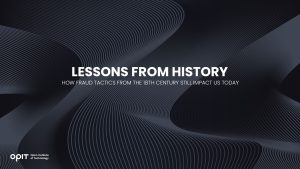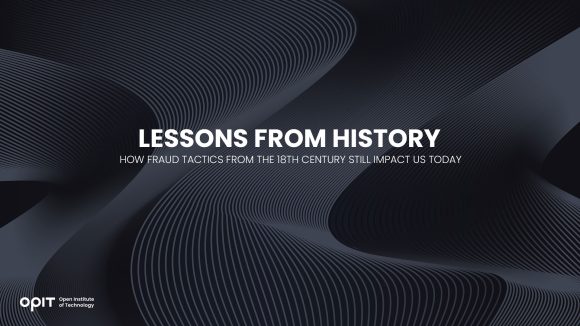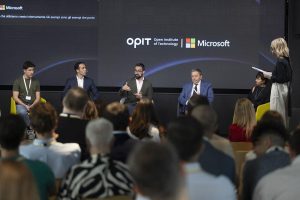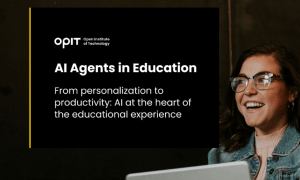

Many people treat cyber threats and digital fraud as a new phenomenon that only appeared with the development of the internet. But fraud – intentional deceit to manipulate a victim – has always existed; it is just the tools that have changed.
In a recent online course for the Open Institute of Technology (OPIT), AI & Cybersecurity Strategist Tom Vazdar, chair of OPIT’s Master’s Degree in Enterprise Cybersecurity, demonstrated the striking parallels between some of the famous fraud cases of the 18th century and modern cyber fraud.
Why does the history of fraud matter?
Primarily because the psychology and fraud tactics have remained consistent over the centuries. While cybersecurity is a tool that can combat modern digital fraud threats, no defense strategy will be successful without addressing the underlying psychology and tactics.
These historical fraud cases Vazdar addresses offer valuable lessons for current and future cybersecurity approaches.
The South Sea Bubble (1720)
The South Sea Bubble was one of the first stock market crashes in history. While it may not have had the same far-reaching consequences as the Black Thursday crash of 1929 or the 2008 crash, it shows how fraud can lead to stock market bubbles and advantages for insider traders.
The South Sea Company was a British company that emerged to monopolize trade with the Spanish colonies in South America. The company promised investors significant returns but provided no evidence of its activities. This saw the stock prices grow from £100 to £1,000 in a matter of months, then crash when the company’s weakness was revealed.
Many people lost a significant amount of money, including Sir Isaac Newton, prompting the statement, “I can calculate the movement of the stars, but not the madness of men.“
Investors often have no way to verify a company’s claim, making stock markets a fertile ground for manipulation and fraud since their inception. When one party has more information than another, it creates the opportunity for fraud. This can be seen today in Ponzi schemes, tech stock bubbles driven by manipulative media coverage, and initial cryptocurrency offerings.
The Diamond Necklace Affair (1784-1785)
The Diamond Necklace Affair is an infamous incident of fraud linked to the French Revolution. An early example of identity theft, it also demonstrates that the harm caused by such a crime can go far beyond financial.
A French aristocrat named Jeanne de la Mont convinced Cardinal Louis-René-Édouard, Prince de Rohan into thinking that he was buying a valuable diamond necklace on behalf of Queen Marie Antoinette. De la Mont forged letters from the queen and even had someone impersonate her for a meeting, all while convincing the cardinal of the need for secrecy. The cardinal overlooked several questionable issues because he believed he would gain political benefit from the transaction.
When the scheme finally exposed, it damaged Marie Antoinette’s reputation, despite her lack of involvement in the deception. The story reinforced the public perception of her as a frivolous aristocrat living off the labor of the people. This contributed to the overall resentment of the aristocracy that erupted in the French Revolution and likely played a role in Marie Antoinette’s death. Had she not been seen as frivolous, she might have been allowed to live after her husband’s death.
Today, impersonation scams work in similar ways. For example, a fraudster might forge communication from a CEO to convince employees to release funds or take some other action. The risk of this is only increasing with improved technology such as deepfakes.
Spanish Prisoner Scam (Late 1700s)
The Spanish Prisoner Scam will probably sound very familiar to anyone who received a “Nigerian prince” email in the early 2000s.
Victims received letters from a “wealthy Spanish prisoner” who needed their help to access his fortune. If they sent money to facilitate his escape and travel, he would reward them with greater riches when he regained his fortune. This was only one of many similar scams in the 1700s, often involving follow-up requests for additional payments before the scammer disappeared.
While the “Nigerian prince” scam received enough publicity that it became almost unbelievable that people could fall for it, if done well, these can be psychologically sophisticated scams. The stories play on people’s emotions, get them invested in the person, and enamor them with the idea of being someone helpful and important. A compelling narrative can diminish someone’s critical thinking and cause them to ignore red flags.
Today, these scams are more likely to take the form of inheritance fraud or a lottery scam, where, again, a person has to pay an advance fee to unlock a much bigger reward, playing on the common desire for easy money.
Evolution of Fraud
These examples make it clear that fraud is nothing new and that effective tactics have thrived over the centuries. Technology simply opens up new opportunities for fraud.
While 18th-century scammers had to rely on face-to-face contact and fraudulent letters, in the 19th century they could leverage the telegraph for “urgent” communication and newspaper ads to reach broader audiences. In the 20th century, there were telephones and television ads. Today, there are email, social media, and deepfakes, with new technologies emerging daily.
Rather than quack doctors offering miracle cures, we see online health scams selling diet pills and antiaging products. Rather than impersonating real people, we see fake social media accounts and catfishing. Fraudulent sites convince people to enter their bank details rather than asking them to send money. The anonymity of the digital world protects perpetrators.
But despite the technology changing, the underlying psychology that makes scams successful remains the same:
- Greed and the desire for easy money
- Fear of missing out and the belief that a response is urgent
- Social pressure to “keep up with the Joneses” and the “Bandwagon Effect”
- Trust in authority without verification
Therefore, the best protection against scams remains the same: critical thinking and skepticism, not technology.
Responding to Fraud
In conclusion, Vazdar shared a series of steps that people should take to protect themselves against fraud:
- Think before you click.
- Beware of secrecy and urgency.
- Verify identities.
- If it seems too good to be true, be skeptical.
- Use available security tools.
Those security tools have changed over time and will continue to change, but the underlying steps for identifying and preventing fraud remain the same.
For more insights from Vazdar and other experts in the field, consider enrolling in highly specialized and comprehensive programs like OPIT’s Enterprise Security Master’s program.
Related posts

Source:
- Times of Malta, published on September 18th, 2025
4 min read
The gathering brought together academics and technology leaders from prominent European Institutions, such as Instituto de Empresa (IE University), OPIT itself and the Royal College of Arts, to explore how artificial intelligence is reshaping the university experience.
The OPIT AI Copilot has been trained on the institute’s complete academic archive, a collection created over the past three years that includes 131 courses, more than 3,500 hours of recorded lectures, 7,500 study resources, 320 certified assessments, and thousands of exercises and original learning documents.
Unlike generic AI tools, the Copilot is deeply integrated with OPIT’s learning management system, allowing it to track each student’s progress and provide tailored support.
This integration means the assistant can reference relevant sources within the learning environment, adapt to the student’s stage of study, and ensure that unreleased course content remains inaccessible.
A mobile app is also scheduled for release this autumn, that will allow students to download exercise and access other tools.
During examinations, the Copilot automatically switches to what the institute calls an “anti-cheating mode”, restricting itself to general research support rather than providing direct answers.
For OPIT’s international community of 500 students from nearly 100 countries, many of whom balance studies with full-time work, the ability to access personalised assistance at any time of day is a key advantage.
“Eighty-five per cent of students are already using large language models in some way to study,” said OPIT founder and director Riccardo Ocleppo. “We wanted to go further by creating a solution tailored to our own community, reflecting the real experiences of remote learners and working professionals.”
Tool aims to cut correction time by 30%
The Copilot will also reduce administrative burdens for faculty. It can help grade assignments, generate new educational materials, and create rubrics that allow teachers to cut correction time by as much as 30 per cent.
According to OPIT, this will free up staff to dedicate more time to teaching and direct student engagement.
At the Milan event, Rector Francesco Profumo underlined the broader implications of AI in higher education. “We are in the midst of a deep transformation, where AI is no longer just a tool: it is an environment that radically changes how we learn, teach, and create,” he said.
“But it is not a shortcut. It is a cultural, ethical, and pedagogical challenge, and to meet it we must have the courage to rethink traditional models and build bridges between human and artificial intelligence.”
OPIT was joined on stage by representatives from other leading institutions, including Danielle Barrios O’Neill of the Royal College of Art, who spoke about the role of AI in art and creativity, and Francisco Machin of IE University, who discussed applications in business and management education.
OPIT student Asya Mantovani, also employed at a leading technology and consulting firm in Italy, gave a first-hand account of balancing professional life with online study.
The assistant has been in development for the past eight months, involving a team of OPIT professors, researchers, and engineers.
Ocleppo stressed that OPIT intends to make its AI innovations available beyond its own institution. “We want to put technology at the service of higher education,” he said.
“Our goal is to develop solutions not only for our own students, but also to share with global institutions eager to innovate the learning experience in a future that is approaching very quickly.”

From personalization to productivity: AI at the heart of the educational experience.
Click this link to read and download the e-book.
At its core, teaching is a simple endeavour. The experienced and learned pass on their knowledge and wisdom to new generations. Nothing has changed in that regard. What has changed is how new technologies emerge to facilitate that passing on of knowledge. The printing press, computers, the internet – all have transformed how educators teach and how students learn.
Artificial intelligence (AI) is the next game-changer in the educational space.
Specifically, AI agents have emerged as tools that utilize all of AI’s core strengths, such as data gathering and analysis, pattern identification, and information condensing. Those strengths have been refined, first into simple chatbots capable of providing answers, and now into agents capable of adapting how they learn and adjusting to the environment in which they’re placed. This adaptability, in particular, makes AI agents vital in the educational realm.
The reasons why are simple. AI agents can collect, analyse, and condense massive amounts of educational material across multiple subject areas. More importantly, they can deliver that information to students while observing how the students engage with the material presented. Those observations open the door for tweaks. An AI agent learns alongside their student. Only, the agent’s learning focuses on how it can adapt its delivery to account for a student’s strengths, weaknesses, interests, and existing knowledge.
Think of an AI agent like having a tutor – one who eschews set lesson plans in favour of an adaptive approach designed and tweaked constantly for each specific student.
In this eBook, the Open Institute of Technology (OPIT) will take you on a journey through the world of AI agents as they pertain to education. You will learn what these agents are, how they work, and what they’re capable of achieving in the educational sector. We also explore best practices and key approaches, focusing on how educators can use AI agents to the benefit of their students. Finally, we will discuss other AI tools that both complement and enhance an AI agent’s capabilities, ensuring you deliver the best possible educational experience to your students.
Have questions?
Visit our FAQ page or get in touch with us!
Write us at +39 335 576 0263
Get in touch at hello@opit.com
Talk to one of our Study Advisors
We are international
We can speak in:
